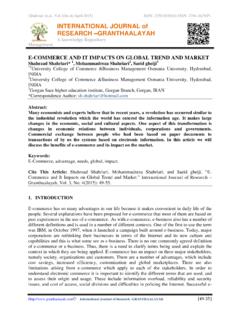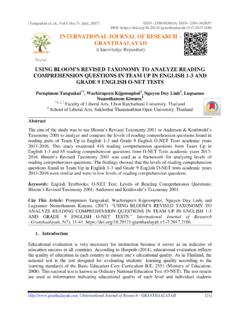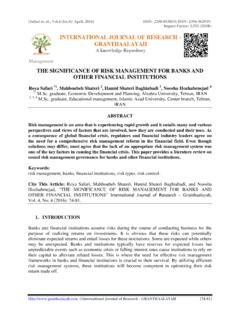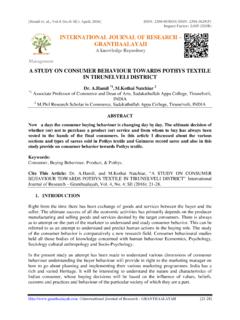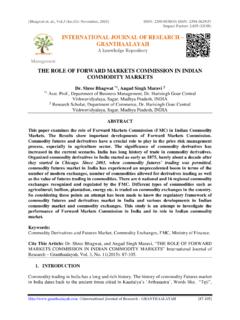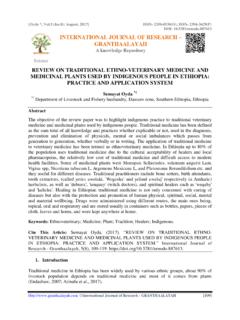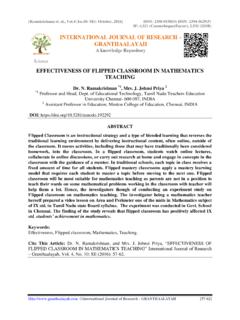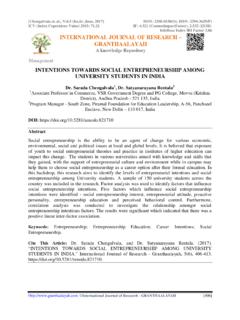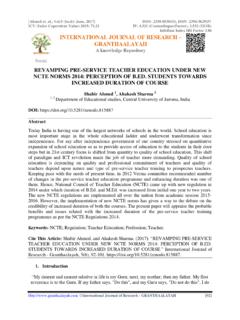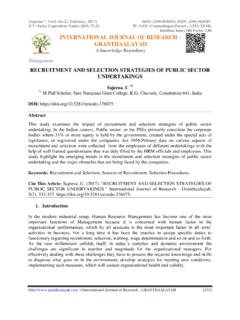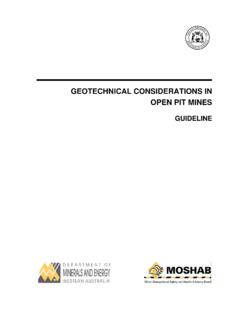Transcription of EFFECTS OF HEAVY METALS ON HUMAN HEALTHEFFECTS OF …
1 [Social Issues and Environmental Problems: September, 2015] ISSN- 2350-0530(O) ISSN- 2394-3629(P) Impact Factor: (I2OR) International Journal of Research - GRANTHAALAYAH [1-7] EFFECTS OF HEAVY METALS ON HUMAN HEALTH Manju Mahurpawar Govt. Autonomous Post Graduate College, Chhindwara ( ) ABSTRACT Some HEAVY METALS have bio-importance as trace elements but the biotoxic EFFECTS of many of them in HUMAN biochemistry are of great concern. Hence, there is a need for proper understanding of mechanism involved, such as the concentrations and oxidation states, which make them harmful. It is also important to know their sources, leaching processes, chemical conversions and their modes of deposition in polluting the environment, which essentially supports life.
2 Literature sources point to the fact that these METALS are released into the environment by both natural and anthropogenic means, especially mining and industrial activities, and automobile exhausts. They leach into the underground waters, moving along water pathways and eventually depositing in the aquifer, or are washed away by run-off into surface waters thereby resulting in water and subsequently soil pollution. Poisoning and toxicity in ecosystem occur frequently through exchange and co-ordination mechanisms. When ingested, they form stable biotoxic compounds, thereby mutilating their structures and hindering bioreactions of their functions. This paper reviews certain HEAVY METALS and their impact and biotoxic EFFECTS on man. Keywords: HUMAN Health, HEAVY Metal, Toxicity, Exposure EFFECTS . INTRODUCTION Metallic elements are intrinsic components of the environment. Their presence is considered unique in the sense that it is difficult to remove them completely from the environment once they enter in it.
3 Metal constitute an important class of toxic substance which are encountered in numerous occupational and environmental circumstances. The impact of these toxic agents on HUMAN health is currently an area of intense interest due to the ubiquity of exposure. With the increasing use of a wide verity of METALS in industry and in our daily life, problems arising from toxic metal pollution of the environment have assumed serious dimensions. SOURCES AND EMISSIONS Toxic METALS , to a large extent, are dispersed in the environment through industrial effluents, organic wastes, refuse burning, and transport and power generation. They can be carried to places many miles away from the sources by wind, depending upon whether they are in gaseous form or as particulates. Metallic pollutants are ultimately washed out of the air into land or the surface of water ways. Thus air is also a route for the pollution of environment.
4 Metal containing industrial effluents constitute a major source of metallic pollution of hydrosphere. Another means of dispersal is the movement of drainage water from catchment areas [Social Issues and Environmental Problems: September, 2015] ISSN- 2350-0530(O) ISSN- 2394-3629(P) Impact Factor: (I2OR) International Journal of Research - GRANTHAALAYAH [1-7] which have been contaminated by waste from mining and smelting units. The chief toxic METALS in industrial effluents are shown in table-1 Table 1: Toxic Metal in Industrial Effluents Metal Manufacturing Industries Arsenic Phosphate and Fertilizer, Metal Hardening , Paints And Textile cadmium Phosphate Fertilizer, Electronics, Pigments And Paints chromium Metal Plating , Tanning, Rubber And Photography copper Plating, Rayon And Electrical Lead Paints, Battery Nickel Electroplating , Iron Steel Zinc Galvanizing, Plating Iron And Steel Mercury Chlor-Alkali, Scientific Instruments , Chemicals TOXIC EFFECTS In general the toxicity of metal ions to mammalians systems is due to chemical reactivity of the ions with cellular structural proteins, enzymes and membrane system.
5 The target organs of specific metal toxicities are usually those organs that accumulate the highest concentrations of the metal in vivo. This is often dependent on the route of exposure and the chemical compound of the metal its valiancy state, volatility, lipid solubility etc. The target organs and clinical manifestations of chronic exposures to the metal are given in table 2 Besides the general toxicities of METALS , we are today also concerned with the potential carcinogenicity of metal compounds. Certain METALS such as chromium and nickel have been linked with cancers in exposed HUMAN populations. METALS have been shown to causes acute as well as chronic poisoning in man and other experimental animals. Harmful EFFECTS of individual METALS are presented briefly below. Table 2: Clinical Aspects of Chronic Toxicities Metal Target Organs Primary Sources Clinical EFFECTS Arsenic Pulmonary Nervous System, Skin Industrial Dusts, Medicinal Uses Of Polluted Water Perforation of Nasal Septum, Respiratory Cancer, Peripheral Neuropathy: Dermatomes, Skin, Cancer Cadmium Renal, Skeletal Pulmonary Industrial Dust And Fumes And Polluted Water And Food Proteinuria, Glucosuria, Osteomalacia, Aminoaciduria, Emphysemia Chromium Pulmonary Industrial Dust And Fumes And Polluted Food Ulcer, Perforation of Nasal Septum, Respiratory Cancer Manganese Nervous System Industrial Dust And Fumes Central And Peripheral Neuropathies [Social Issues and Environmental Problems.]
6 September, 2015] ISSN- 2350-0530(O) ISSN- 2394-3629(P) Impact Factor: (I2OR) International Journal of Research - GRANTHAALAYAH [1-7] Lead Nervous System, Hematopoietic System, Renal Industrial Dust And Fumes And Polluted Food Encephalopathy, Peripheral Neuropathy, Central Nervous Disorders, Anemia. Nickel Pulmonary, Skin Industrial Dust, Aerosols Cancer, Dramatis Tin Nervous , Pulmonary System Medicinal Uses, Industrial Dusts Central Nervous System Disorders, Visual Defects And EEG Changes, Pneumoconiosis. Mercury Nervous System, Renal Industrial Dust And Fumes And Polluted Water And Food Proteinuria 1 Arsenic: Soluble inorganic arsenic can have immediate toxic EFFECTS . Ingestion of large amounts can lead to gastrointestinal symptoms such as severe vomiting, disturbances of the blood and circulation, damage to the nervous system, and eventually death.
7 When not deadly, such large doses may reduce blood cell production, break up red blood cells in the circulation, enlarge the liver, color the skin, produce tingling and loss of sensation in the limbs, and cause brain damage. Long-term exposure to inorganic arsenic in drinking water in Taiwan has caused black foot disease, in which the blood vessels in the lower limbs are severely damaged, resulting eventually in progressive gangrene. The relationship between arsenic exposure and other health EFFECTS is less clear. The evidence is strongest for high blood pressure, heart attacks and other circulatory disease. The evidence is weaker for diabetes and reproductive EFFECTS ; it is weakest for strokes, long-term neurological EFFECTS , and cancer at sites other than lung, bladder, kidney and skin. as well as other skin changes such as hyperkeratosis and pigmentation changes. These EFFECTS have been demonstrated in many studies using different study designs.
8 Exposure response relationships and high risks have been observed for each of these end-points. The EFFECTS have been most thoroughly studied in Taiwan but there is considerable evidence from studies on populations in other countries as well. Increased risks of lung and bladder cancer and of arsenic-associated skin lesions have been reported to be associated with ingestion of drinking-water at concentrations 50 g arsenic/litre. Occupational exposure to arsenic, primarily by inhalation, is causally associated with lung cancer. Exposure response relationships and high risks have been observed. Increased risks have been observed at cumulative exposure levels (mg/m3) year ( 15 years of exposure to a workroom air concentration of 50 g/m3). EFFECTS on HUMAN health Lead is a toxic HEAVY metal even at very low levels of exposure in humans. Its effect on the HUMAN body can be both acute and chronic depending on dose and exposure scenarios.
9 Lead targets multiple organs in the body due to its systemic toxicity which can cause neurological, cardiovascular, renal, gastro-intestinal, haematological and reproductive EFFECTS . HUMAN exposure to lead is usually tested through blood sampling. The lead stored in the bones can emerge as a remobilised form of lead exposure late in the life of the individual. Exposure occurs primarily through inhalation of dust particles, air contaminated with lead and ingestion of foodstuffs, water and dust. Inhalation is an important exposure pathway for people in the vicinity of point sources such as lead contaminated sites, countries where leaded fuel is still used and areas where waste from products containing lead is burnt as well as secondary lead recovery operations. Apart from ingestion of lead on foodstuffs and in drinking water a major exposure source is leaded [Social Issues and Environmental Problems: September, 2015] ISSN- 2350-0530(O) ISSN- 2394-3629(P) Impact Factor: (I2OR) International Journal of Research - GRANTHAALAYAH [1-7] paint.
10 Dust in homes containing leaded paint can be inhaled by adults and children and ingested by children through pica behaviour. 2 Cadmium: EFFECTS on HUMAN health Humans are exposed to cadmium by inhalation and ingestion although the main health impacts recorded in the literature are through dietary exposure (kidney and bone damage) and inhalation from smoking tobacco and occupational exposure (lung damage). Dietary intake accounts for 90% of all exposure in non-smokers. Cadmium in the environment is toxic to plants and animals and many micro-organisms. Cadmium does not degrade in the environment to less toxic products which contributes to its bioaccumulation in the kidneys and liver of vertebrates and invertebrates. Cadmium enters the environment from a variety of anthropogenic sources. Wastewater is key source of environmental cadmium contamination and diffuse pollution occurs through industrial air emissions and widespread use of fertilizers on agricultural soils.
